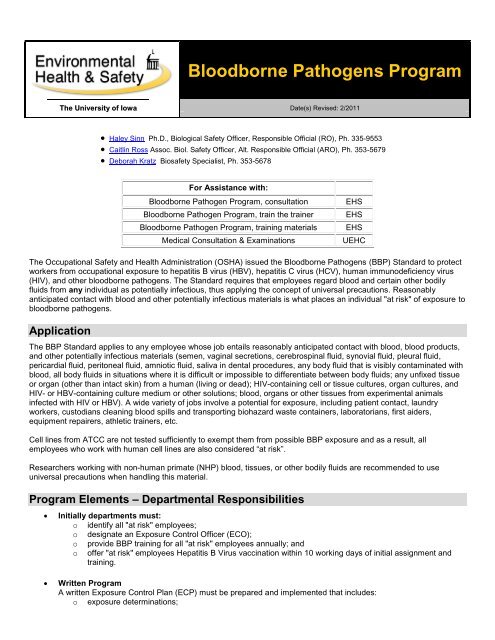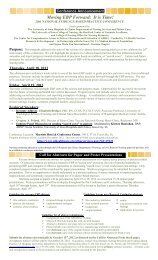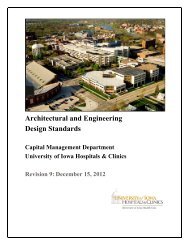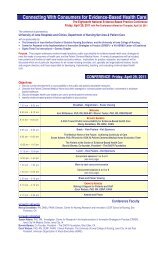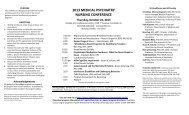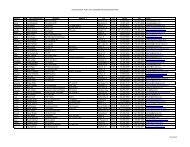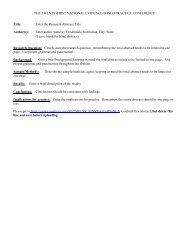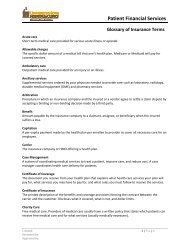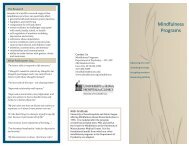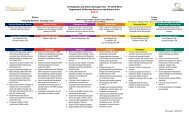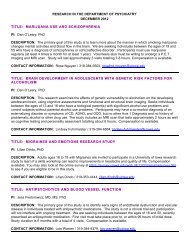Bloodborne Pathogens Program - University of Iowa Hospitals and ...
Bloodborne Pathogens Program - University of Iowa Hospitals and ...
Bloodborne Pathogens Program - University of Iowa Hospitals and ...
You also want an ePaper? Increase the reach of your titles
YUMPU automatically turns print PDFs into web optimized ePapers that Google loves.
<strong>Bloodborne</strong> <strong>Pathogens</strong> <strong>Program</strong><br />
The <strong>University</strong> <strong>of</strong> <strong>Iowa</strong> Date(s) Revised: 2/2011<br />
Haley Sinn Ph.D., Biological Safety Officer, Responsible Official (RO), Ph. 335-9553<br />
Caitlin Ross Assoc. Biol. Safety Officer, Alt. Responsible Official (ARO), Ph. 353-5679<br />
Deborah Kratz Biosafety Specialist, Ph. 353-5678<br />
For Assistance with:<br />
<strong>Bloodborne</strong> Pathogen <strong>Program</strong>, consultation<br />
<strong>Bloodborne</strong> Pathogen <strong>Program</strong>, train the trainer<br />
<strong>Bloodborne</strong> Pathogen <strong>Program</strong>, training materials<br />
Medical Consultation & Examinations<br />
EHS<br />
EHS<br />
EHS<br />
UEHC<br />
The Occupational Safety <strong>and</strong> Health Administration (OSHA) issued the <strong>Bloodborne</strong> <strong>Pathogens</strong> (BBP) St<strong>and</strong>ard to protect<br />
workers from occupational exposure to hepatitis B virus (HBV), hepatitis C virus (HCV), human immunodeficiency virus<br />
(HIV), <strong>and</strong> other bloodborne pathogens. The St<strong>and</strong>ard requires that employees regard blood <strong>and</strong> certain other bodily<br />
fluids from any individual as potentially infectious, thus applying the concept <strong>of</strong> universal precautions. Reasonably<br />
anticipated contact with blood <strong>and</strong> other potentially infectious materials is what places an individual "at risk" <strong>of</strong> exposure to<br />
bloodborne pathogens.<br />
Application<br />
The BBP St<strong>and</strong>ard applies to any employee whose job entails reasonably anticipated contact with blood, blood products,<br />
<strong>and</strong> other potentially infectious materials (semen, vaginal secretions, cerebrospinal fluid, synovial fluid, pleural fluid,<br />
pericardial fluid, peritoneal fluid, amniotic fluid, saliva in dental procedures, any body fluid that is visibly contaminated with<br />
blood, all body fluids in situations where it is difficult or impossible to differentiate between body fluids; any unfixed tissue<br />
or organ (other than intact skin) from a human (living or dead); HIV-containing cell or tissue cultures, organ cultures, <strong>and</strong><br />
HIV- or HBV-containing culture medium or other solutions; blood, organs or other tissues from experimental animals<br />
infected with HIV or HBV). A wide variety <strong>of</strong> jobs involve a potential for exposure, including patient contact, laundry<br />
workers, custodians cleaning blood spills <strong>and</strong> transporting biohazard waste containers, laboratorians, first aiders,<br />
equipment repairers, athletic trainers, etc.<br />
Cell lines from ATCC are not tested sufficiently to exempt them from possible BBP exposure <strong>and</strong> as a result, all<br />
employees who work with human cell lines are also considered “at risk”.<br />
Researchers working with non-human primate (NHP) blood, tissues, or other bodily fluids are recommended to use<br />
universal precautions when h<strong>and</strong>ling this material.<br />
<strong>Program</strong> Elements – Departmental Responsibilities<br />
<br />
Initially departments must:<br />
o identify all "at risk" employees;<br />
o designate an Exposure Control Officer (ECO);<br />
o provide BBP training for all "at risk" employees annually; <strong>and</strong><br />
o <strong>of</strong>fer "at risk" employees Hepatitis B Virus vaccination within 10 working days <strong>of</strong> initial assignment <strong>and</strong><br />
training.<br />
<br />
Written <strong>Program</strong><br />
A written Exposure Control Plan (ECP) must be prepared <strong>and</strong> implemented that includes:<br />
o exposure determinations;
o<br />
o<br />
o<br />
o<br />
methods <strong>of</strong> compliance, e.g. use <strong>of</strong> Universal Precautions, work practice controls, engineering controls<br />
<strong>and</strong> personal protective equipment (PPE);<br />
medical surveillance;<br />
training; <strong>and</strong><br />
post-exposure procedures.<br />
EHS has developed a <strong>Bloodborne</strong> <strong>Pathogens</strong> Exposure Control Plan template to assist departments in<br />
completing their Exposure Control Plans. This word document provides a st<strong>and</strong>ard format <strong>and</strong> guides<br />
departments where department/area specific information must be added, or where appropriate, sections can be<br />
deleted.<br />
<br />
Exposure Control Officer (ECO)<br />
Each department will designate an individual as their ECO. Responsibilities <strong>of</strong> the ECO include:<br />
o reviewing <strong>and</strong> updating the exposure determination for the department, identifying all “at risk” employees;<br />
o annually reviewing <strong>and</strong> updating the Exposure Control Plan, communicating all changes to personnel;<br />
<strong>and</strong><br />
o ensuring all persons “at risk” <strong>of</strong> BBP exposure within their department receive the necessary training <strong>and</strong><br />
vaccinations<br />
o providing all persons “at risk” <strong>of</strong> BBP exposure within their department the location <strong>of</strong> the written program<br />
Periodically, EHS will <strong>of</strong>fer a training session for the ECO’s.<br />
<br />
<br />
Medical Surveillance<br />
Departments must provide the Hepatitis B vaccine series to "at risk" employees, at no cost to the employee. The<br />
<strong>University</strong> Employee Health Clinic (UEHC) at 356-3631 provides this service. However, an MFK must be provided<br />
to UEHC to cover the cost <strong>of</strong> the vaccine. If an employee declines the vaccine, a waiver must be signed <strong>and</strong> will<br />
be kept on file by UEHC.<br />
Post-exposure evaluation <strong>and</strong> follow-up are provided by UEHC, call 356-3631.<br />
Training<br />
Each department is responsible for training its employees who are determined to be at risk <strong>of</strong> occupational<br />
exposure. Training courses for “at risk” employees are available online through EHS, located at:<br />
https://research.uiowa.edu/ehs/training. There are 4 different BBP courses available, make sure the employee(s)<br />
takes the course appropriate for each department:<br />
o BBP for Lab Workers is designed for laboratory employees <strong>and</strong> students upon initial training.<br />
o BBP for Non-lab Workers is designed for non-laboratory staff, such as Athletics, Residence Services,<br />
Public Safety, etc. upon initial <strong>and</strong> annual refresher training.<br />
o BBP for College <strong>of</strong> Public Health is designed only for College <strong>of</strong> Public Health faculty, staff <strong>and</strong><br />
students upon initial training.<br />
o BBP Refresher is designed as a refresher course for laboratory employees <strong>and</strong> students across campus<br />
(CPH <strong>and</strong> others). The refresher course may be taken annually only if staff has already completed the<br />
BBP for Lab Workers or BBP for CPH courses during their initial training.<br />
If you have any questions as to which course should be completed, please call EHS (5-8501).<br />
When completing BBP for Lab Workers <strong>and</strong> BBP for Non-lab Workers courses online, additional, site-specific,<br />
departmental information must be provided in order to be in regulatory compliance with OSHA. A site-specific<br />
training form is available within the course content; it is the responsibility <strong>of</strong> the employee, along with their<br />
supervisor or designated work area trainer, to complete the site-specific training <strong>and</strong> maintain a copy <strong>of</strong> this<br />
record.<br />
A few departments on campus <strong>of</strong>fer BBP training from within the department. Staff <strong>and</strong> students attending this<br />
training do not need to complete EHS’s online BBP course.<br />
General requirements for training are that it must be:<br />
o at the time <strong>of</strong> initial assignment to tasks where occupational exposure may take place;<br />
o conducted annually thereafter; <strong>and</strong><br />
o given when changes or modifications in procedures occur that affect the employee's occupational<br />
exposure.
Topics to be covered in all information <strong>and</strong> training programs include:<br />
o regulatory text <strong>of</strong> the st<strong>and</strong>ard;<br />
o Exposure Control Plan, including location;<br />
o epidemiology <strong>and</strong> symptoms <strong>of</strong> bloodborne pathogens;<br />
o modes <strong>of</strong> transmission <strong>of</strong> bloodborne pathogens;<br />
o methods for recognizing tasks <strong>and</strong> activities that place employees at risk;<br />
o use <strong>and</strong> limitations <strong>of</strong> methods <strong>of</strong> control to prevent occupational exposure;<br />
o basis for selection <strong>of</strong> PPE <strong>and</strong> information on the types, proper use, location, removal, h<strong>and</strong>ling,<br />
decontamination, <strong>and</strong> disposal <strong>of</strong> PPE;<br />
o information on the HBV vaccine <strong>and</strong> benefits <strong>of</strong> being vaccinated;<br />
o post-exposure follow-up procedures <strong>and</strong> evaluation the employer must provide for the employee;<br />
o explanation <strong>of</strong> signs, labels, <strong>and</strong> tags used to denote biohazards; <strong>and</strong><br />
o spill response procedures.<br />
Additional training is required for personnel working in HIV <strong>and</strong> HBV Research Laboratories <strong>and</strong> Production<br />
Facilities.<br />
<br />
Documentation<br />
Accurate records must be maintained <strong>of</strong>:<br />
o the written Exposure Control Plan;<br />
o Exposure Incident Forms;<br />
o training syllabus <strong>and</strong> attendance records; <strong>and</strong><br />
o medical surveillance.<br />
References<br />
<br />
<br />
<br />
<br />
<br />
<strong>Bloodborne</strong> <strong>Pathogens</strong> Exposure Control Plan template<br />
Annual <strong>Program</strong> Review Form<br />
Exposure Incident Form<br />
OSHA BBP29CFR1910.1030<br />
Biohazard Waste Guide (This guide was created using Adobe Acrobat Writer. Please download Adobe Acrobat Reader now if you do not<br />
have it.)


